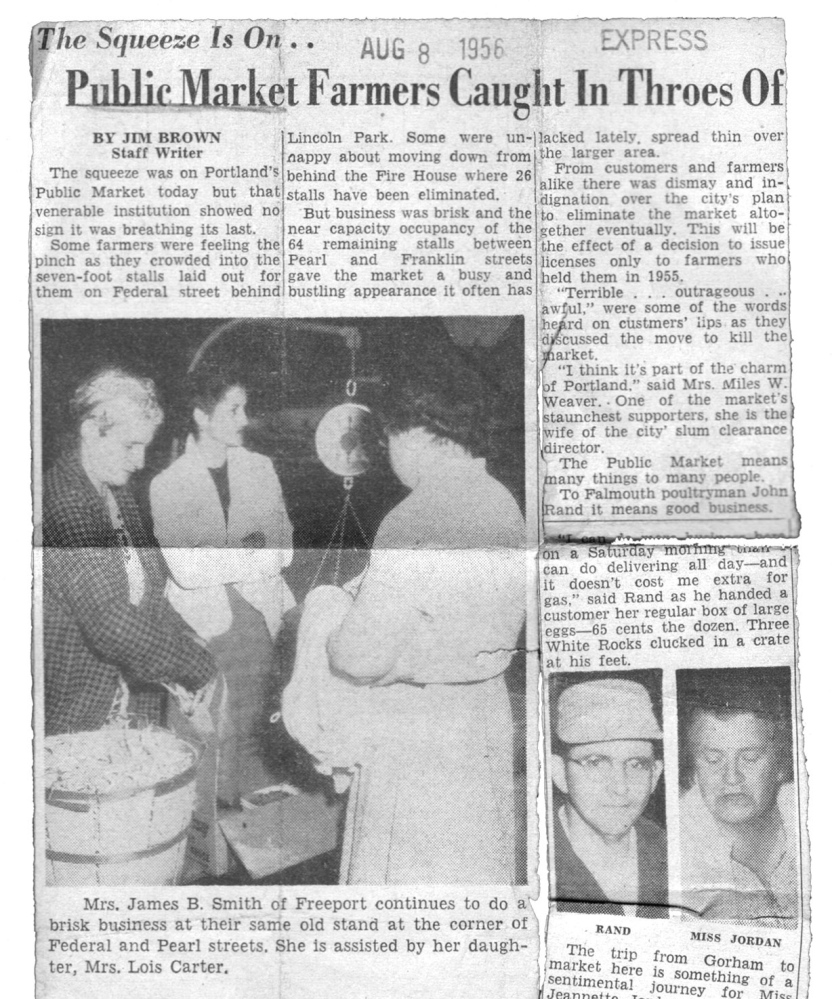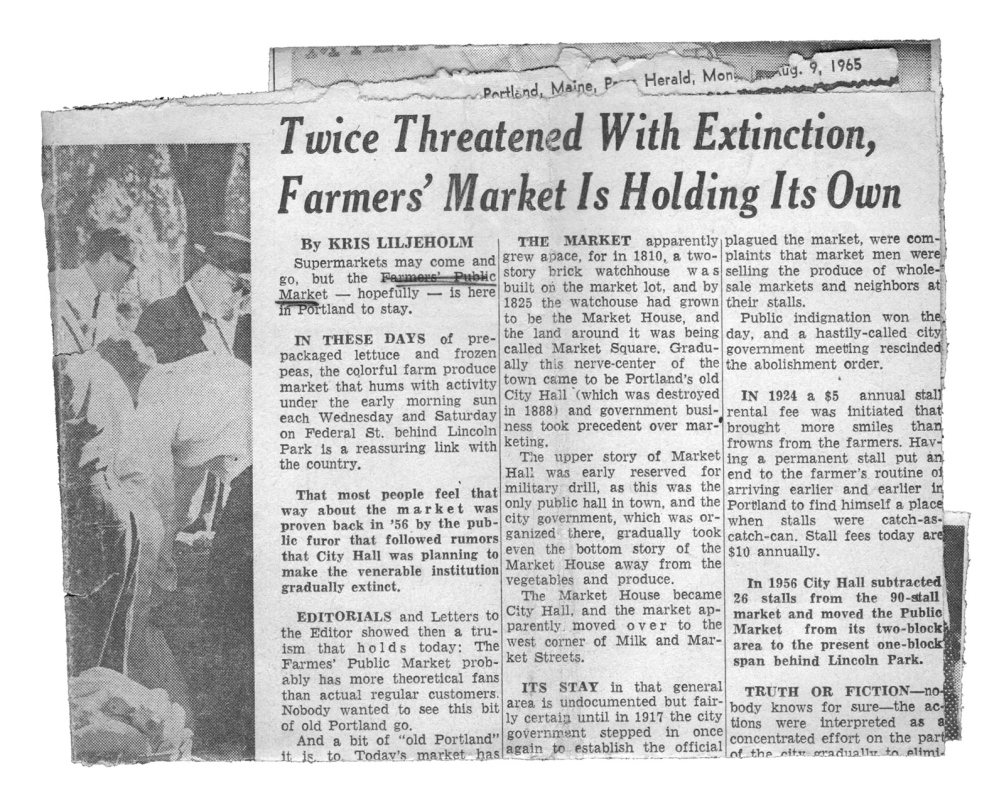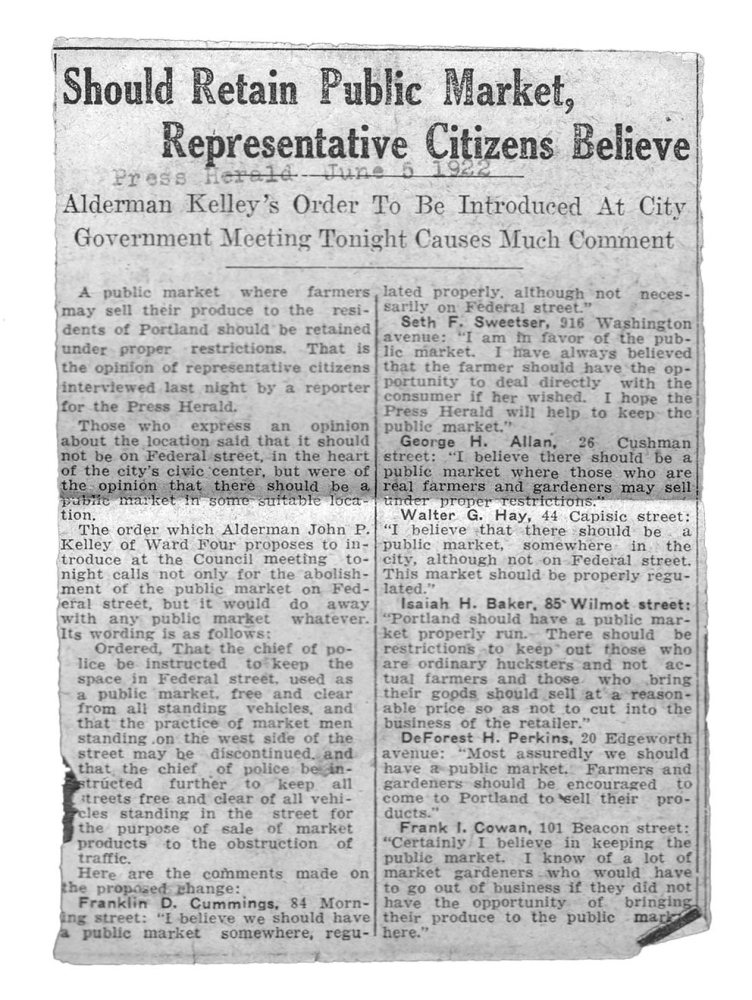EDITOR’S NOTE: This is Part 2 of an article on the history of Maine’s farmers markets. You can find Part 1, published May 11, online at http://bit.ly/1hXyNo2.
When Portland’s first farmers market was established almost 250 years ago, there were just 200 houses or so on the peninsula.
It was a small number considering the town’s excellent port and the fact that the area had been settled for more than 150 years, but attacks by Native Americans and enemies of Britain had twice destroyed the growing town, slowing its progress in agriculture and trade.
By the time the city chose Resurgam, or “I will rise again,” as the motto for its seal in 1786, Portland was rebuilding yet again after a bombardment by the British Navy destroyed most of the city, including its farmers market.
Over the centuries, the market rose and fell, and rose again, along with the fortunes of the city. Over the market’s 246-year lifespan, it has moved at least half a dozen times, operated indoors and out, sometimes at multiple locations, and has almost been extinguished by industrial agriculture and the popularity of supermarkets.
The Portland Farmers’ Market has been shaped by centuries of regulations, from the city to the federal level. Its produce has arrived on horseback and oxcart, by wagon, sleigh, canal and railroad, and by truck and automobile to be sold at market stalls, curbside stands and in parking lots.
In the 17th and 18th centuries, Portlanders were carving out a home for themselves amid the swamps and wildlife that still defined “the Neck,” shorthand for Falmouth Neck, as Portland was then known. To supply their own food needs, families typically kept a garden and a milk cow, sometimes hogs or laying hens. A 1775 map shows tidy orchards dotting the Neck. Those who had a surplus from their gardens, fruit trees and animals could hawk it around the town alongside others who sold foraged berries or raked oysters.
MEETING GROWING DEMAND
But as Portland’s population swelled in the mid-18th century, the land available for keeping gardens and livestock shrank while the demand for food increased.
Colonists were just beginning to settle and plant Maine’s fertile interior, and many farmers supported the development of their farms by engaging in more readily lucrative trades, such as harvesting lumber or manufacturing lumber products. As a sideline, these loggers and craftsmen often kept orchards or farmed staple crops like corn, which they could bring into Portland to trade along with their lumber products. They brought livestock, too, and eggs, milk, cheese or surplus produce from the family garden. (Even today, farming is not the primary occupation of the majority of Maine’s farmers.)
With the increasing traffic of wagons, carts, sleighs and wheelbarrows, Portland’s already lively streets became even more so. Bakers’ boys were known to go hurtling down Fish Street (now the lower part of Exchange) on their wheelbarrows and hand sleds, creating such a hazard that the town made the activity an offense punishable by a $1 fine.
The presence of street vendors was so familiar to city dwellers around the country in those days that early Americans used their cries to teach children their ABCs.
Illustrated sheets, known as battledores, pictured the vendors with their produce or wares. One popular version (from 1810, some years after Portland’s farmers market opened) was “The Uncle’s Present: A New Battledore.” In it, the letter E was illustrated by a woodcut of a woman with a basket of eels balanced on her head and her cry, “Eels, live eels, large silver eels.” The letter F was a fowl seller with baskets of birds suspended on either end of a pole across his shoulders. “Fowls, live fowl or fat chicken?”)
Charming as that sounds to us today, at the time the town selectmen increasingly saw a need to regulate the peddlers, as well as to monitor the quality and measure of goods offered for sale.
Initially, the selectmen authorized the police inspector – and later, the clerk of the markets – to set up temporary “market places” so vendors could conduct business without disrupting street and sidewalk traffic, an offense that also carried a fine. By 1768, they found the farmers a home, setting up market stalls on the lower floors of the meeting house, or “town house,” on the corner of King (now India) and Middle streets, and creating Portland’s first farmers market.
In 1774, the building that housed the market was moved to Hampshire Street near Congress, where it was destroyed when the British bombarded the town the following year.
MOVING THE GOODS
Getting goods to market wasn’t easy in the 1800s and even into the early part of the 20th century, when farmers were still bringing produce to Portland via horse and wagon. Merchants couldn’t just load up the truck and hop on the interstate. Poor roads and limited transportation options were the rule, factors that made markets necessarily local.
“Doubtless Maine roads were as good as roads elsewhere in New England except in the most populous sections; but for all that they were wretchedly poor,” wrote Clarence Day in “A History of Maine Agriculture, 1604-1860.” “At best they were narrow and filled with rocks and ruts, and in fall and spring they were barely passable for weeks on end.”
Two-wheeled ox carts that could move over primitive roads carried most of the farm produce that moved overland, and they moved very slowly. The usual way of getting meats, butter and eggs to market, historian Edward Goold wrote, was in large leather saddlebags or panniers, secured on the back of a horse.
The market roads were easier to navigate in winter over packed snow and ice, and goods could be sleighed in from as far away as Vermont. “The long trains of loaded sleighs, which came in the winter over the Fort Hill Road (now Route 114), were imposing spectacles,” Goold wrote of trade at Gorham in the early 1800s. “Of course, nearly all were bound for the larger market of Portland, but many stopped here overnight at the taverns. At times when the sleighing to Portland was poor, much of their trade was here.”
As Portland’s population continued to grow and business became more concentrated around today’s Monument Square (then known as Haymarket, since it was the location of the town hay scale, or simply Market Square,) two more markets were established: one on Market Square, sometime after 1797, and the other, in 1805, on the west corner of Milk and Market Streets.
The first clerk of the market was appointed in 1818, “to preserve order in the markets.” He was charged with making sure food was fresh, that scales gave true weight, and that market produce was sold by its producer, not a re-seller. Purchase and re-sale of produce at an inflated price by third parties was forbidden by town ordinances against forestalling – that is, buying or selling of produce outside designated market places. The regulation was intended to let towns collect stall revenues, to protect public health, and to help ensure fair access and fair prices by limiting sales to specific places, days and times. Elements of this old ordinance live on in Maine’s farmers markets today, many of which require that goods be sold directly by the grower.
MARKETS DIVERSIFY
During Portland’s reign as state capital (1820 to 1832), the old market house was moved to clear the lot for a new and larger city hall to accommodate government business. Completed in 1825, the new city hall functioned as a military drill hall (top story), town hall (middle story) and market (stalls on the ground level).
By the 1860s, a new city hall had been built yet again, and the now old combination city hall and market was renamed the Market House. Sellers who did not rent a stall there, or at the Milk Street Market, could sell at designated public stands and marketplaces throughout the city that were set by the type of goods sold. Ordinances specified that butchers’ meat could be sold only on the north side of Fore Street between Silver and Willow, the west side of Union between Fore and Middle, or the south side of Fore between Richardson’s and Union Wharfs.
“Country produce” had more territory, including several blocks on Congress, Fore and Exchange Streets.
At the turn of the 19th century, the Market House was demolished to make way for the “Our Lady of Victories” Civil War memorial, and Market Square was transformed into Monument Square.
Business continued into the 20th century at the Milk Street Market and various city-designated stands and market places. In 1917 the city set up a curbside market at Lincoln Park, as recommended by the U.S. Department of Agriculture (USDA), which had developed a new model market system for the nation. USDA guidelines judged Portland’s population too small to justify the expense of a permanent market building.
It wasn’t long before the Milk Street Market ceased to be part of the city’s public market system. A 1922 news item in the Press Herald reported that the city was considering abandoning it. In 1924, a market farmer from East Otisfield, surprised to find that the Milk Street Market stalls were now privately owned, complained in a letter to the editor:
“We think it would have been very courteous and helpful if the City Government had informed the farmers of Cumberland County that it (the public market) was done away with so those that are working sixteen hours a day would not get up at two o’clock in the morning and load up and travel over those awful roads, forty miles, only to be ordered out by a pompous policeman…We wish the farmers had any rights in the world, except to pay taxes.”
FALLOW FIFTIES, THEN REVIVAL
During its best times, the Lincoln Park market drew more than 100 farmers from a 20-mile radius, with some coming from as far away as Bethel. But by the 1950s, the city considered turning the area over to parking meters.
Dalton Grover, a farmer who’d begun selling at the market in 1917, remarked in a 1954 interview in the Press Herald: “You hardly ever see young people around the public market.… Looks like the young wives of today prefer their vegetables from cans.” The market struggled on at Lincoln Park until 1976, when it was moved to the Golden Triangle, at the time a parking lot and now the site of One City Center, just off Monument Square.
The 1976 move came just as the tide was beginning to turn in support of farmers markets in Maine and around the nation. When One City Center was built in 1990, the market moved back to what has become known as its home base – Monument Square.
There, on spring, summer and fall Wednesdays, and in Deering Oaks Park on Saturdays, the market has enjoyed an incredible resurgence, embodying the resiliency expressed by the city’s motto. Resurgam, indeed.
Meg Ragland is a librarian, former chef and culinary historian who is working on her first book, “Boston: A Food Biography.”
Copy the Story Link
Send questions/comments to the editors.





Success. Please wait for the page to reload. If the page does not reload within 5 seconds, please refresh the page.
Enter your email and password to access comments.
Hi, to comment on stories you must . This profile is in addition to your subscription and website login.
Already have a commenting profile? .
Invalid username/password.
Please check your email to confirm and complete your registration.
Only subscribers are eligible to post comments. Please subscribe or login first for digital access. Here’s why.
Use the form below to reset your password. When you've submitted your account email, we will send an email with a reset code.